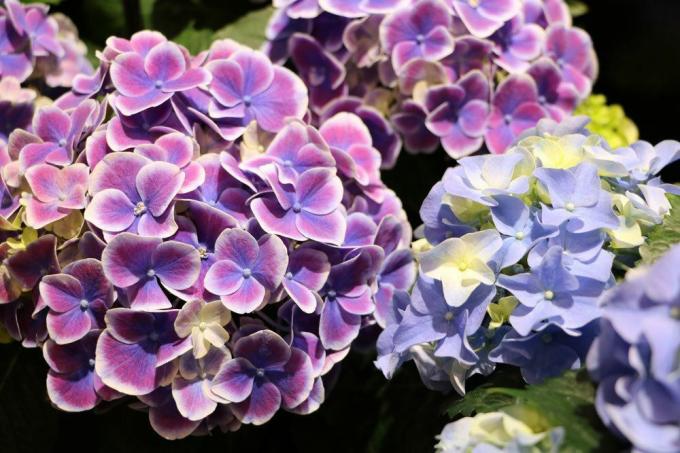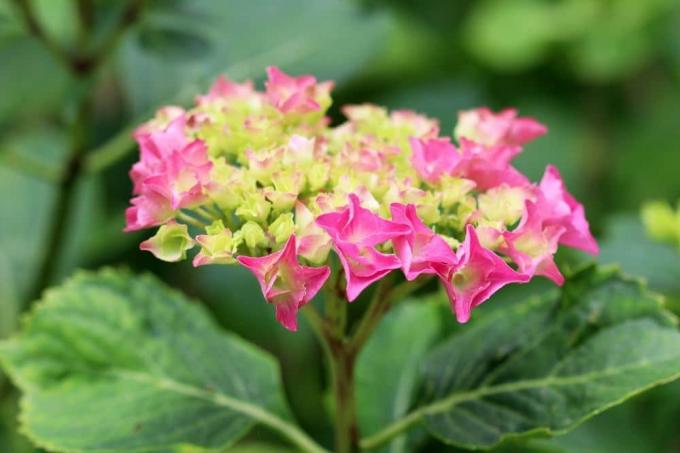
table of contents
- Causes and Actions
- Wrong cutting measures
- Too shady location
- Lack of winter protection
- Nutritional deficiency
- First year
- dryness
- Incorrect fertilizer additions
Hydrangeas are known for their abundant inflorescences in many different hues, which present themselves in the garden from June to the end of September. For the gardener, it is best when your own hydrangeas bloom in gorgeous colors and beautify the garden, balcony or terrace. However, it can happen that the hydrangea does not bloom. There are numerous causes for this problem and solutions to get the beautiful Hydrangeaceae to bloom again.
Causes and Actions
Hydrangeas are known as robust plants, but numerous care mistakes can significantly limit the joy of flowering. These range from the wrong place in the garden to the unfavorable cutting times and the nature of the soil. The advantage: Mistakes in care can be easily rectified and the hydrangea will bloom in the next season at the latest. The following paragraphs discuss the possible reasons for a rotten hydrangea and the necessary treatment.
Wrong cutting measures
One of the most common reasons your hydrangea won't bloom is to prune heavily in the spring. That only applies Plate hydrangeas (bot. Hydrangea serrata) and Garden hydrangeas (bot. Hydrangea macrophylla). These develop their flower buds in autumn and carry them in the shoots into the new year. They sit directly under the old flowers and are thus protected from the winter cold. If you prune the hydrangea too hard in spring, you will remove the flower buds, which will destroy a flower that year. For this reason, in spring you should only cut as follows:
- only remove old flowers
- only cut to the next bud
- use sharp, clean scissors for this
Make sure you leave the new buds intact, as incorrect pruning will damage them irrevocably. Therefore, proceed carefully and, above all, carefully.

tip: You will not face this problem if you plant one of the hydrangea varieties 'Endless Summer' or 'Forever and Ever'. These are the only garden hydrangeas that can be severely cut back after winter and then develop new flower buds in the same year.
Too shady location
For a hydrangea to bloom, it needs an ideal location. This is especially important for specimens that freshly planted and still have to get used to the location. The plants tolerate partial shade without any problems, but should only remain in the shade for a short time. A bright, sunny place with protection from the midday sun should be chosen so that it can get enough light but does not burn. Replant the plant accordingly or look for a new place for specimens in the tub.
tip: A partially shaded place with sufficient light also attracts pollinator insects. Since these also prefer warm and light places, they help for a corresponding abundance of flowers.
Lack of winter protection
Although the hydrangea with its withered inflorescences has good winter protection, the winter can become too much for it without appropriate measures. The reason for this is again the buds of the garden and plate hydrangeas, which freeze to death without protection over the winter. The following hydrangeas, on the other hand, do not form buds in autumn, which requires little or no winter protection:
- Panicle hydrangea (bot. Hydrangea paniculata)
- Forest hydrangeas (bot. Hydrangea arborescens)
- Oak-leaved hydrangea (bot. Hydrangea quercifolia)
Protect the buds of your plate and garden hydrangeas from damage over the winter time with the following winter measures:
- Brushwood or mulch made from leaves is used as winter protection
- Distribute this directly on the floor
- wrap hydrangea with garden fleece on colder days
- Remove garden fleece in frost-free times
- Place the potted plants in a light, sheltered place
- Cold house, stairwell, winter garden recommended
- Cover the pot with garden fleece
The hydrangeas can now recover and produce numerous flowers in the next summer.
tip: You have to be particularly careful with late frosts in spring, as these can severely damage the leaves and bracts of the hydrangea buds. In order for the buds to survive until summer, you should always keep an eye on the weather report in spring and wrap the plant in a garden fleece on frosty days.
Nutritional deficiency
If the soil conditions are unsuitable for the plants, they cannot absorb sufficient nutrients that are important for flower formation. A common problem that many people overlook is trees. If hydrangeas are planted near larger trees, there will be a deficiency, as these steal the hydrangeas their nutrients. So choose a location that is a bit away from trees. If you cannot find a suitable place, you should increase the fertilizer additions a little to compensate for the deficit.
tip: Avoid the stalwart crop often to transplant. They often react to this by failing to bloom.
First year
If you've just planted your hydrangeas, don't worry if they don't bloom over the summer. Hydrangeas need some time to develop and will only present them in the following year of planting, as they first have to get used to their new place in the garden. If you implement the care effectively over the first year, the hydrangea will bloom in the next season and you can look forward to the splendor of flowers. Here it simply means: wait and see.
dryness
One of the biggest mistakes in grooming is dryness. Many hydrangea owners overlook this, as the plants are quite robust and take some time to show that they need water. From spring to autumn this is not a problem, as you can orientate yourself on the soil or the substrate of the plant. In winter, however, you need to take extra care that your hydrangeas are protected from drying out. Drought damage over the winter can seriously affect the plants, so there is little chance that they will bloom in the following summer. The following steps will help you:
1. Provide specimens in the bucket or pot with sufficient irrigation water over the winter. Regularly check potted plants that are in their winter quarters for dry substrate. Take advantage of the Finger test and make sure you never let the hydrangeas stand bone dry for more than two days.
2. Bedding plants also need to be added water when the winters are sunny and very cold but dry. On frost-free days, check the soil and water accordingly. Never water in frosty weatherOtherwise the freezing water will cause frost damage.
3. Pay attention to both variants Waterlogging. This can quickly lead to the death of the plant due to root rot.
Incorrect fertilizer additions
In addition to the nutrient deficiency mentioned above, it is possible that the flowering of your hydrangeas fails because the nitrogen and phosphate concentration is too one-sided. The phosphate in particular is important for flower formation. Garden soils contain sufficient phosphate, but many people fertilize hydrangeas with horn shavings. These contain high amounts of nitrogen, which can lead to a deficiency of phosphorus over a long period of time. Therefore, you should only supply the plant with one of the following fertilizers to stimulate flower formation:
- Hydrangea fertilizer
- Azalea fertilizer
- Rhododendron fertilizer
- high quality bloom fertilizer
- Cattle manure
You can recognize a phosphate deficiency by the condition of the hydrangea shoots. If these grow extremely vigorously and act like a trunk, the plant receives too much nitrogen.






